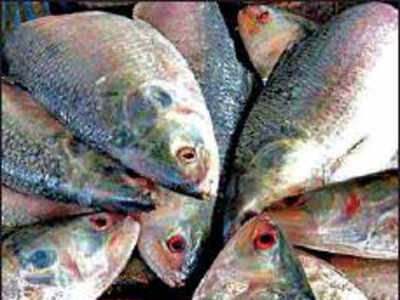Top Searches
- News
- India News
- Spiralling fuel costs may spell doom for the hilsa
Spiralling fuel costs may spell doom for the hilsa

Representative image
KOLKATA: The ceaseless spike in fuel prices isn’t just burning holes in pockets – it has also stalled the engine of hilsa growth in the Bay of Bengal. As fishermen skimp on fuel and cast fine nets in shallow waters along the coastline instead of venturing deep into the sea, more juvenile hilsa are getting caught than the full-grown ones that are prized for their taste.
While hilsa fish live in saline waters, they migrate to rivers to lay eggs before returning to the sea. Shoals of young hilsa making their way back to the sea are now getting caught in the fine nets laid close to the shoreline. Catching hilsa under 500gm was banned in India, Bangladesh and Myanmar nearly three decades ago to protect the fast depleting fish population. Bangladesh has been successful in enforcing the ban and reviving the hilsa population in its waters, but India and Myanmar have had moderate success.
With the price of diesel increasing by over 30% in the past 12 months, enforcing the ban on catching juvenile hilsa is proving to be a challenge. Last week, a raid by the fisheries department netted one tonne of juvenile hilsa from a trawler that had returned to Bengal’s Kakdwip. The fishermen admitted their catch was from shallow waters close to the shore.
A year ago, a round trip for deep-sea fishing by a trawler used to cost Rs 1.5 lakh, including the salaries and food of the 15-16 fishermen who were on board.
“We would spend 1,200 litres of fuel for a 15-day trip and the expense came to around Rs Rs 84,000. Now just 800 litres of fuel costs us Rs 75,000 and since other expenses have also increased, we are fishing along the coastline,” said Rabin Das, who owns multiple trawlers.
What this essentially means is that while trawlers used to venture around 450km into the sea earlier. Now, they travel just around 270km. South 24 Parganas fisheries assistant director (marine) Jayanta Pradhan said nearly all fishermen were now indulging in illegal fishing practices.
While hilsa fish live in saline waters, they migrate to rivers to lay eggs before returning to the sea. Shoals of young hilsa making their way back to the sea are now getting caught in the fine nets laid close to the shoreline. Catching hilsa under 500gm was banned in India, Bangladesh and Myanmar nearly three decades ago to protect the fast depleting fish population. Bangladesh has been successful in enforcing the ban and reviving the hilsa population in its waters, but India and Myanmar have had moderate success.
With the price of diesel increasing by over 30% in the past 12 months, enforcing the ban on catching juvenile hilsa is proving to be a challenge. Last week, a raid by the fisheries department netted one tonne of juvenile hilsa from a trawler that had returned to Bengal’s Kakdwip. The fishermen admitted their catch was from shallow waters close to the shore.
A year ago, a round trip for deep-sea fishing by a trawler used to cost Rs 1.5 lakh, including the salaries and food of the 15-16 fishermen who were on board.
“We would spend 1,200 litres of fuel for a 15-day trip and the expense came to around Rs Rs 84,000. Now just 800 litres of fuel costs us Rs 75,000 and since other expenses have also increased, we are fishing along the coastline,” said Rabin Das, who owns multiple trawlers.
What this essentially means is that while trawlers used to venture around 450km into the sea earlier. Now, they travel just around 270km. South 24 Parganas fisheries assistant director (marine) Jayanta Pradhan said nearly all fishermen were now indulging in illegal fishing practices.
FacebookTwitterLinkedinEMail
Start a Conversation
end of article
Quick Links
Coronavirus in MumbaiFarm bill 2020Farmers protestCoronavirus in DelhiCoronavirus in BangaloreCoronavirus symptomsCoronavirus in IndiaWest Bengal elections 2021Coronavirus NewsSolar EclipseNPRWhat is NRCCAB BillCAB and NRCAssam election 2021Podcast newsLok SabhaTamil Nadu Election 2021CongressBJP newsKerala Elections 2021Indian ArmyISRO newsSupreme Court

